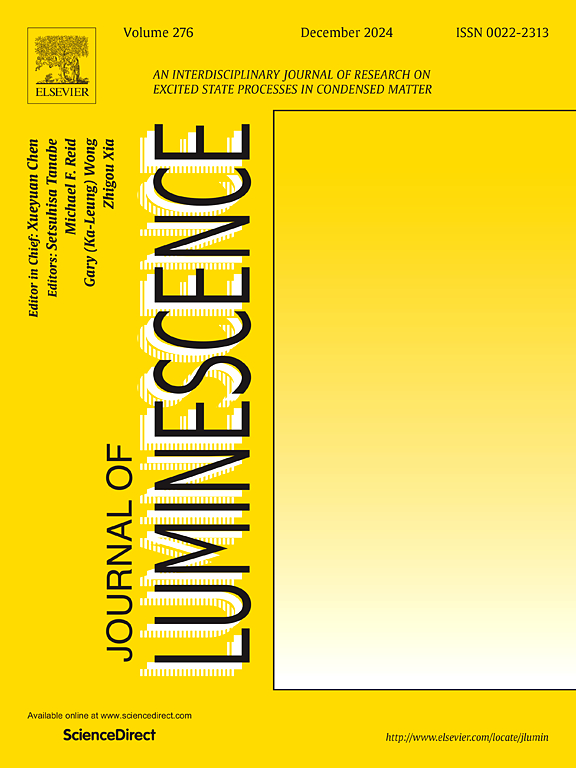浓度依赖和颜色可调的碳dots@boric酸复合材料的室温余辉
IF 3.6
3区 物理与天体物理
Q2 OPTICS
引用次数: 0
摘要
可调色室温余辉(RTA)材料在信息加密和防伪等领域具有广泛的应用前景。然而,以一种简单的方式实现颜色可调的余辉材料仍然是一个相当大的挑战。近年来,碳点在制备无金属长余辉材料方面受到越来越多的关注。本文提出了一种方便、低成本、不同掺杂浓度制备具有超长寿命RTA的碳dots@boric酸(CDs@BA)复合材料的策略。令人兴奋的是,CDs@BA-(Ⅰ,Ⅱ,Ⅲ和Ⅳ)复合材料不仅具有超长的余辉寿命,而且还具有从绿松石色到深黄色余辉的颜色可调特性。此外,这些CDs@BA复合材料已成功应用于安全出口标志和危险物质标志的光学图案设计中。这些发现可能为环境条件下具有超长余辉和颜色可调余辉的cds纳米材料的设计提供了新的途径。本文章由计算机程序翻译,如有差异,请以英文原文为准。

Concentration-dependent and color-tunable room temperature afterglow of carbon dots@boric acid composites
Color-tunable room temperature afterglow (RTA) materials have become excellent candidates for a wide range of applications in information encryption and anti-counterfeiting. However, the achievement of color-tunable afterglow materials in a simple way remains a considerable challenge. In recent years, carbon dots (CDs) have attracted more and more attention in preparing metal-free long afterglow materials. Herein, a convenient and low-cost strategy with different doping concentrations for the preparation of carbon dots@boric acid (CDs@BA) composites with ultralong lifetime RTA has been proposed. Excitingly, the CDs@BA-(Ⅰ, Ⅱ, Ⅲ and Ⅳ) composites not only have ultralong afterglow lifetimes, but also exhibit color-tunable properties ranging from turquoise to deep yellow afterglow. In addition, these CDs@BA composites have been successfully used in the optical pattern design of safety exit signs and hazardous material signs. These findings may provide a new approach for the design of CDs-based nanomaterials with ultralong and color-tunable afterglow under ambient conditions.
求助全文
通过发布文献求助,成功后即可免费获取论文全文。
去求助
来源期刊

Journal of Luminescence
物理-光学
CiteScore
6.70
自引率
13.90%
发文量
850
审稿时长
3.8 months
期刊介绍:
The purpose of the Journal of Luminescence is to provide a means of communication between scientists in different disciplines who share a common interest in the electronic excited states of molecular, ionic and covalent systems, whether crystalline, amorphous, or liquid.
We invite original papers and reviews on such subjects as: exciton and polariton dynamics, dynamics of localized excited states, energy and charge transport in ordered and disordered systems, radiative and non-radiative recombination, relaxation processes, vibronic interactions in electronic excited states, photochemistry in condensed systems, excited state resonance, double resonance, spin dynamics, selective excitation spectroscopy, hole burning, coherent processes in excited states, (e.g. coherent optical transients, photon echoes, transient gratings), multiphoton processes, optical bistability, photochromism, and new techniques for the study of excited states. This list is not intended to be exhaustive. Papers in the traditional areas of optical spectroscopy (absorption, MCD, luminescence, Raman scattering) are welcome. Papers on applications (phosphors, scintillators, electro- and cathodo-luminescence, radiography, bioimaging, solar energy, energy conversion, etc.) are also welcome if they present results of scientific, rather than only technological interest. However, papers containing purely theoretical results, not related to phenomena in the excited states, as well as papers using luminescence spectroscopy to perform routine analytical chemistry or biochemistry procedures, are outside the scope of the journal. Some exceptions will be possible at the discretion of the editors.
 求助内容:
求助内容: 应助结果提醒方式:
应助结果提醒方式:


